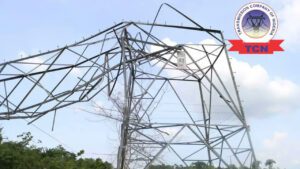
Flooding projections: Local, State & Federal Govts must observe their statutory duties
The annual records of flood incidents with associated damages and losses in Nigeria have kept on taking toll year-in-year-out. Across the Country, the narratives of flood disasters, apparently may not have spared any part. While flooding is known to be a phenomenon that can be found taking its course in communities in any nation around the world, the Nigerian case has been troubling with poor attention to address the disaster, particularly, where they are mostly preventable and man-made at large.
The ugly events speak to the significance of emergency approach to develop overarching measures to prevent future occurrences of such mishaps. It is believed that while torrential and heavy downpour of rain cannot be ruled out, yet they can be managed from constituting disasters to prevent the tolls of losses taking records yearly. Projections of more incidents of flooding have been given to further take course this year. For instance, the Nigerian Meteorological Agency (NiMet) has predicted excessive rainfall in Northern states of Nigeria, including Katsina, Borno, Sokoto, Kano, Jigawa, Gombe, Yobe, Bauchi and Adamawa, which is likely to make them experience flooding in August, September and October this year. The Director-General of the agency,Professor Mansur Matazu, while addressing journalists at NiMet’s headquarters, Abuja, on Tuesday, 16th August 2022, had further mentioned that parts of Kebbi, Zamfara, Kaduna, Nasarawa, Taraba and Yobe States may face medium risk of experiencing flooding within the same period. Matazu also identified the South-Western states of Lagos, Ogun, Osun, Oyo and parts of Ekiti and Edo states in South-South as areas likely to experience normal to abnormal rainfall within the same period.
The fear of flood mishaps have raised alarm, as projections of torrential rainfall have come up in view. It is indisputable that it is only by proactive disposition to raise response mechanisms that the incidence of disasters can be prevented from projected heavy downpours. Such response much be overarching and systemic.
However, controversies may not seem not to take place as to whose responsibility it is to build the architecture to prevent flood disasters. The Presidency, had on Tuesday, 23rd August 2022, barely a week after NiMet’s heavy downpour projections, challenged States to “face their duties of managing the flooding within their jurisdictions.”
In a statement signed by the Senior Special Assistant to the President on Media and Publicity, Garba Shehu, the Presidency had argued that those calling on the Federal Government to respond to every outbreak of natural disaster do not display an understanding of Nigerian law. The Presidency explained that the Local, State and Federal governments have a sizeable budget at their disposal, allocated monthly for dealing with state-level natural emergencies and national-level natural emergencies.
The Presidency stated that the legal structure of the response mechanism on natural disaster mandated the Central Government to directly address national-level emergencies and that Local Government Councils and the states were the first responders in all situations. In the statement entitled ‘Flooding in several Nigerian states and the triple response structure,’ the Presidency stated that: “Calls for the Federal Government to respond to all outbreaks of natural disaster do not just display an understanding of Nigerian law. While not a national-level emergency, the ongoing flooding is an emergency nevertheless. Nigerian lives and property are at stake. We call on Governors of those states that have swung into action and engaged the necessary gear to continue with their efforts, and those that have not, to immediately face their duties of managing the flooding within their jurisdictions – that is, the job that the President, Governors and Council Chairmen have been elected to do. It is not clear why some of the State Governments in question are not already drawing upon those funds to tackle the current emergency, and the general population is misguidedly calling on the Federal Government to intervene in all situations. If those monies are, for whatever reason, no longer available, the affected States and Local councils must immediately contact the relevant authorities to explain what has happened with those funds.”
Explaining the revenue allocation formula, the Presidency noted that 2.32 per cent of derivation funds is allocated for ecology and disaster management. “Of this amount, the 36 States and the FCT get 0.72 per cent, the 774 Local Governments get 0.6 per cent, adding to 1.32 percent, leaving a balance of one per cent to the government of the federation. By the law of land, NEMA takes 20 per cent of the amount allocated to the Federal Government. The North-East Development Commission collects 10 per cent, the National Agricultural Land Development Authority, 10 per cent, and the National Agency for the Great Green Wall, 0.5 per cent, leaving 0.55 of the one per cent to the government at the centre for ecological protection and disaster management.
“While expressing his concerns over the hardships being faced by people due to this natural calamity, the President noted that the National Emergency Management Agency had written to each of the 36 states of the federation through the States’ respective Governors advising on the appropriate action to take in view of the gloomy forecasts of the rains this year.
“The Federal Government will continue to work closely with the State Governments to provide all possible assistance to overcome this challenge, the President expects at the same time it must be seen as a shared responsibility. The response to emergencies must stand on the three-legged structure. Instead of making headline grabbing calls, politicians should take the trouble to find out from the Ministries and State Governments what steps are being taken in the face of these challenges,” the Presidency had held.
It is essential for the National Emergency Management Agency (NEMA) as well as the Emergency Management Agencies of the States, particularly those highlighted above in the projections, to intensify adaptation, mitigation and other response mechanisms to foreclose eventualities of flood disasters that may lead to human and economic losses. The necessity to commence and/or strengthen, as the case may be, awareness campaigns is pertinent. Leveraging response strategies by engaging field extension workers for possible response activities in preparation, particularly for high risk areas is pertinent. Insensitivity to the significance of hydrological and meteorological, as well as urban and physical planning architectures, have been noted to be responsible for major environmental disasters in the Country, particularly flooding, experienced recurrently across States in the Country. To prevent the occurrences of mishaps from such disasters as flooding, critical attention must be paid to the mechanisms of these architectures, while displaying responsiveness to building these structures remains pertinent. Such responsiveness demands conscious efforts that must be sustained and developed for a long lasting solution to the problem of flooding, among other disasters. It is pertinent, however, to note that only an architecture of overarching response system is required to manage the projected heavy downpour to avert incidence of flooding disasters. Hence, such overarching system is one demanding concerted efforts from all level of governments. To this effect, no level of government from all sides should neglect its duty. Such neglect may leave behind lacuna that may give room to breaches which may permit damages that may be too costly. Since the law has clearly stated the sphere of jurisdiction for each level of government, and the budgetary allocations for the responsibilities bordering on the subject have always been earmarked appropriately, there is no excuse or hiding ground for any level of government, from whatever part, to renege on its duty. Hence, responsiveness and proactivity must be displayed from all sides as duty demands.



